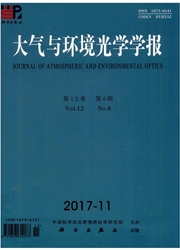

 中文摘要:
中文摘要:
利用偏振激光雷达对南京2015年3月一次沙尘和细粒子污染共存过程的颗粒物垂直分布特征进行观测研究,结合地面气象数据、PM2.5和PM10质量浓度数据、PM2.5组分数据、卫星MODIS测量结果,探讨不同颗粒形态下的气象因素、颗粒物浓度分布、组分特征以及颗粒物光学特性的时间演变和垂直分布特征。结果表明:高湿、弱风等不利气象条件利于二次粒子的生成和累积,期间水溶性组分中SNA(SO4-2、N03、NH+)等二次组分浓度明显升高;同一时期长距离输入的沙尘发生的沉降对地面PM2.5化学组分构成显著影响,3月21日下午时段至3月22日在1.1-2.5km高度的沙尘颗粒物向地面输送造成地面PM2.5的ca2+突然增大到3.2μg/m3;3月22日下午以后在东南气流影响下,地面PM2.5向西扩散,PM2.5颗粒物浓度得到有效稀释,同时段出现了沙尘输入和扬尘过程,扬尘过程和沙尘输入使地面的粗颗粒增多,PM10剧增至347#g/m3;南京与无锡地区的颗粒物时空分布呈现高度相似的变化特点,具有区域性分布特征。后向轨迹分析表明,500m、800m及1000m三个高度气团移动方向基本一致,主要从内蒙、京津冀、山东等地入海,后又经东海返回内陆抵达南京。
 英文摘要:
英文摘要:
The vertical distribution characteristics of a dust and fine particle pollution process of Nanjing were measured and studied by polarization lidar in March, 2015. The meteorological factors, particle concentration distribution, particle composition and optical properties of different kinds of particles were discussed, combining with ground meteorological data, PM2.5 and PM10 concentration data, PM2.5 component data and the result observed by MODIS satellite. The results indicate that the adverse weather conditions such as high humidity and weak wind are favorable for the formation and accumulation of the secondary particles, and the SNA (SO42-, NO3, NH+) concentration of soluble components showed a significant increasing trend during the experimental period. At the same time, the settlements of sand particle from long distance significantly influenced the chemical composition of the ground PM2.5. The dust particles from 1.1 km to 2.5 km were transported to the ground during afternoon of March 21 to March 22, which caused Ca2+ iron concentration of PM2.5 increase to 3.2 μg/m3 suddenly. The PM2.5 spread to the west and the PM2.5 concentration was reduced efliciently under the influence of southeast current after afternoon in March 22. At the same time, dust transport and fugitive dust occurred, causing the concentration of coarse particles up to 347 #g/m3. Compared with the particle distribution of Wuxi, the particle distribution characteristics in Nanjing showed highly similar characteristics, it indicated the particles distribution was regional. Finally the backward trajectory analysis showed that the backward trajectories were largely consistent at the height of 500 m, 800 m and 1000 m, the air mass mainly originated from Mongolia, and passed Beijing, Shandong, then moved to the East China Sea,finally backed to Nanjing.
 同期刊论文项目
同期刊论文项目
 同项目期刊论文
同项目期刊论文
 期刊信息
期刊信息
